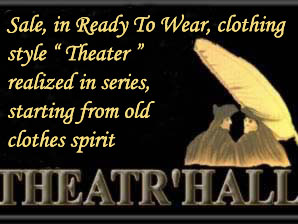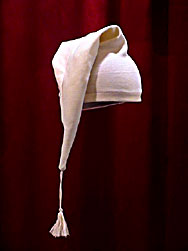 |
 |
||||
 |
|||||
Sales of theatrical clothes and disguises (jabot shirts with or without lace, cape, hats, wigs and Venetian masks, vests and old trousers) for all public, weddings, fancy dress, costumers, and public spectacles.
Also discover on our website all personal achievements, available from stock in our warehouse in Paris.
On our WEB site, you can :
- To buy by correspondence
via this WEB site
and even
CONTACT : THEATRHALL
Phone calls to France: + 33.1.43.26.64.90 (after 15h)
N° VAT Intracomm. - SIRET - APE - RIB - General Conditions of Sale
teatral teatrall teatrale teatrales téâtral téâtrall
téâtrale téâtrales theatrical théâtrall
theatrical theatrical theatrical theatrall theatrical theatrical theater
hall theater all teatrhall teatre hall
The second illustration shows the Little red Riding Hood and the wolf,
lying in the same bed, just before the dévoration. The small
girl in his/her/its nightcap, spellbound and intrigued, seem contorted
at the same time. Whereas all his/her/its behavior hesitates between
attraction and the repulsion, it maintains the sheet of a chaste gesture
on his/her right shoulder has the height of the nightcaps whereas his/her
eyes seem to tell the wolf the opposite of that that his/her/its gesture
evokes. The aggressiveness of the animal intrigued by his/her/its nightcap
is demonstrated by his/her claws exits as well as by his/her/its greedy
look. Having replaced his/her/its hood-beret by a nightcap made of laces,
unknoted hair, symbolic traditionally erotic, the child seems more mature
than in the first illustration. The opposition of the looks crossed
creates one moment of dramatic suspense that lets foretell a brutal
outcome. But the travesty of the wolf in nightcap can also lend to smile,
because this one donned the nightcap trimmed with ribbons of the grand'mère
and one can wonder of course why the small girl doesn't unmask it. Because
this is not the grand'mère who is disguised itself in wolf, to
frighten his/her/its small girl?
This is not her who tells itself storyteller, and hurry on the child
dressed in his/her/its nightcap to devour it (of kisses?) as the annotation
indicates it to the manuscript of 1695: "One pronounces these words
of a strong voice, to frighten the child as if the wolf the alloit to
eat."
Educational tracks :

